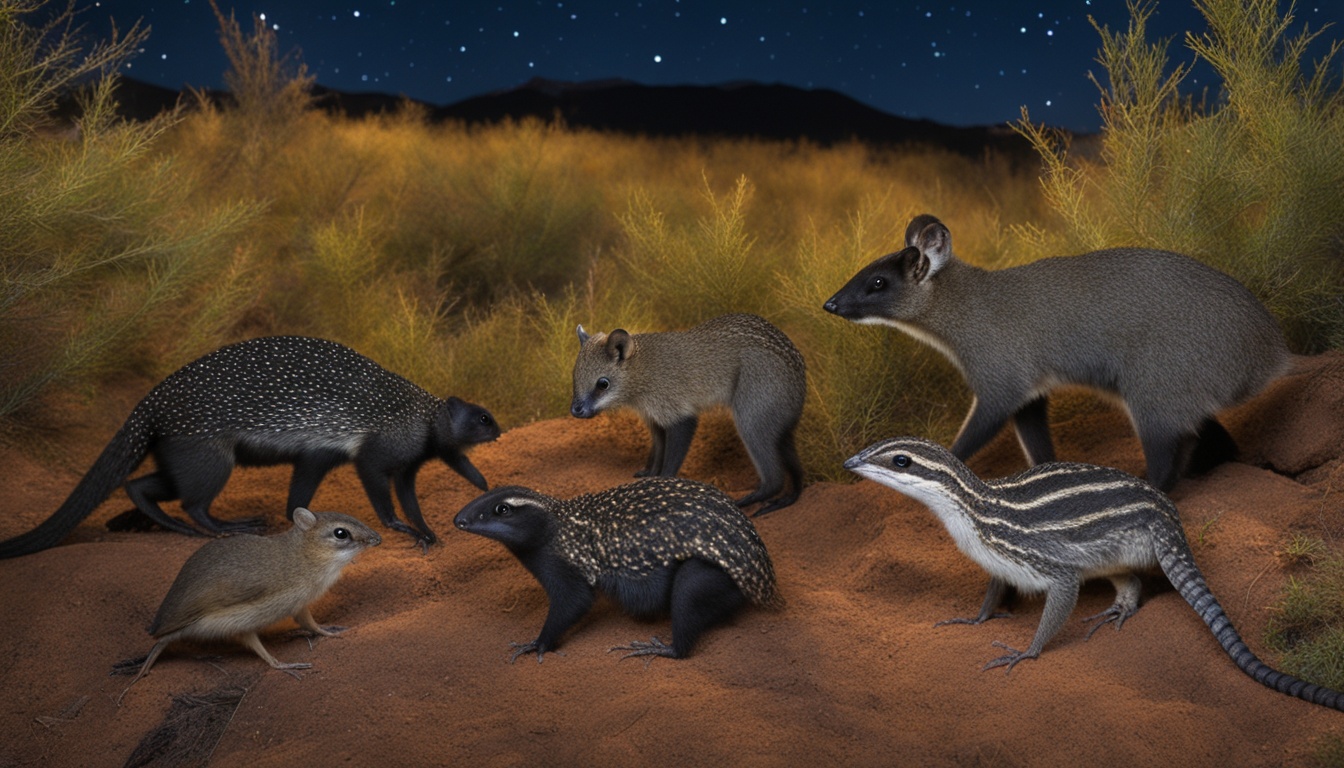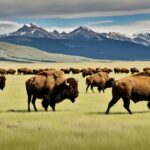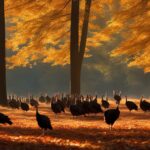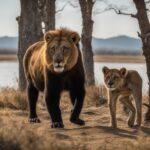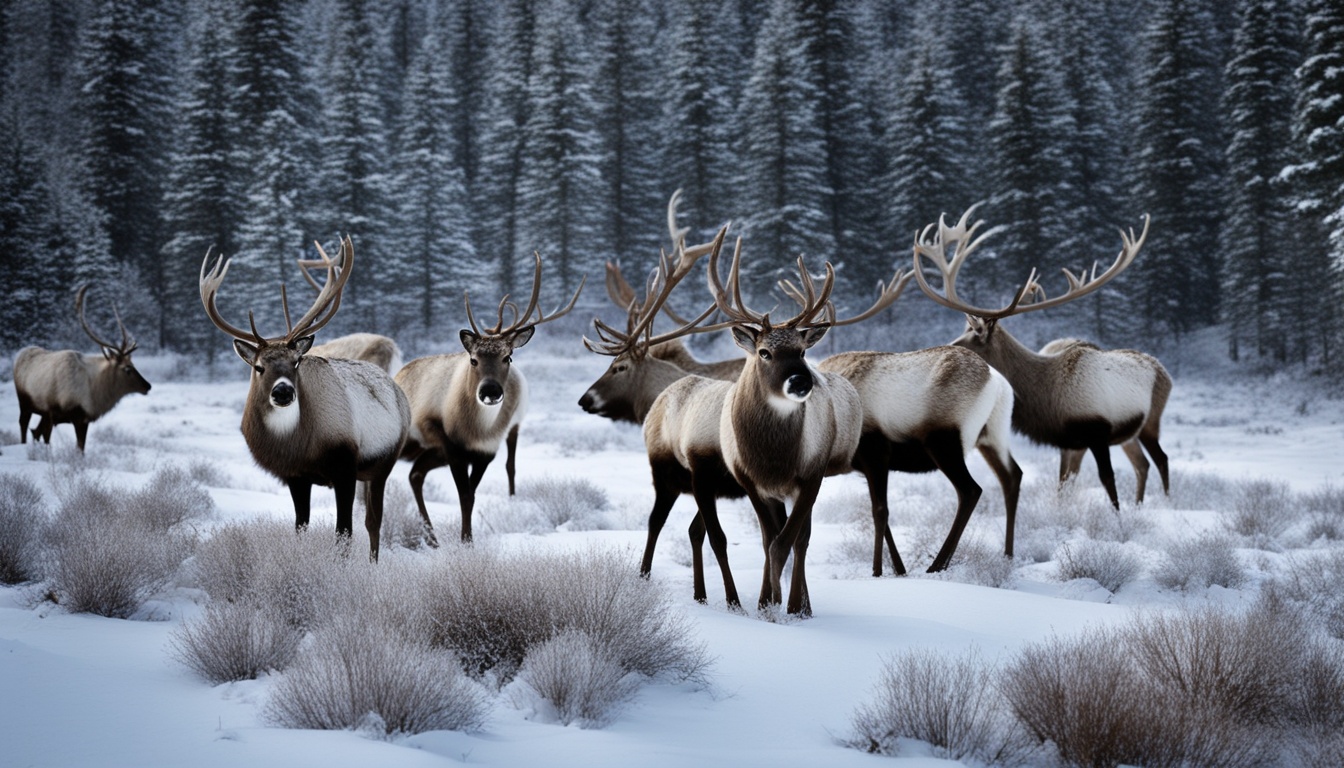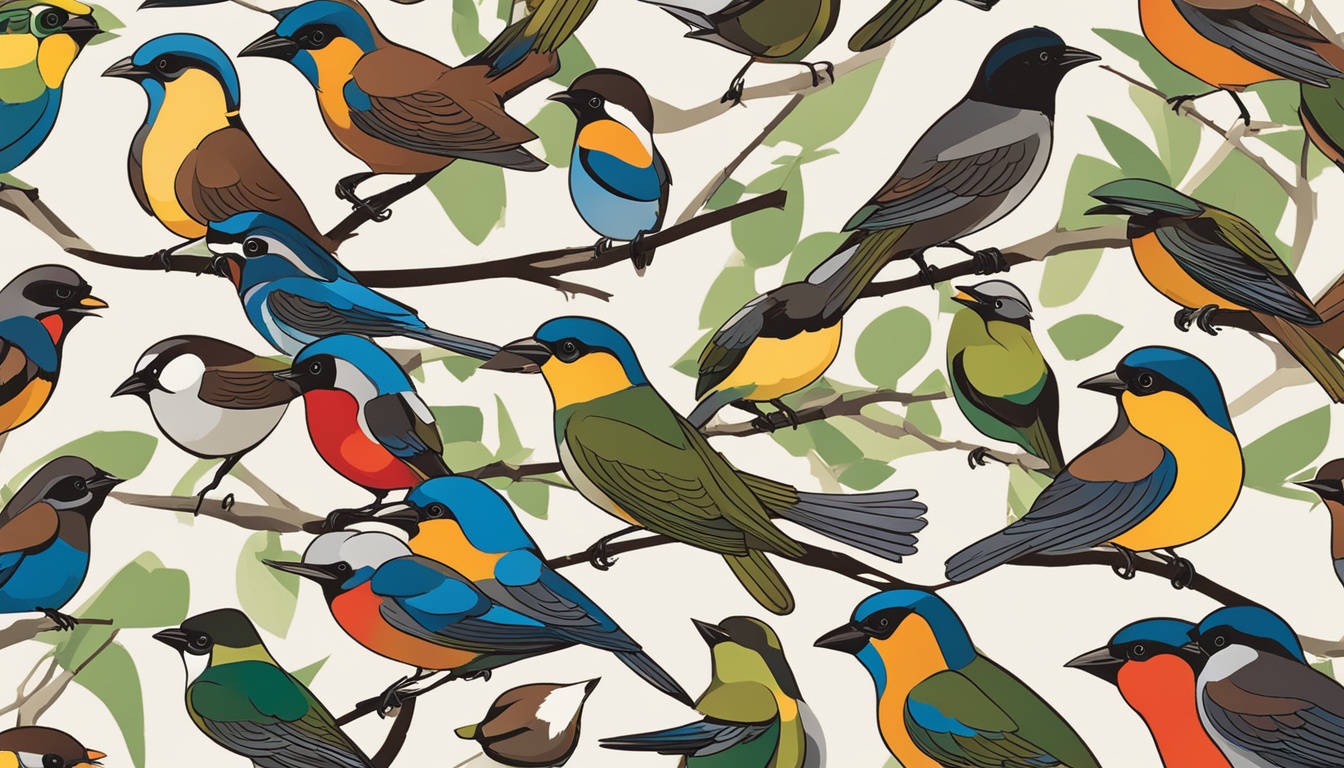Have you thought about the animals that move around the American night? While we’re sleeping, creatures like raccoons, bats, and barn owls are active. They use the darkness to hunt, find food, and mate. This helps them avoid danger and find more food. Each of these animals has special skills for living in the dark.
Introduction to Nocturnal Animals in the USA
Nocturnal animals in the USA have cool ways to live in the night. They use their senses differently and find food in unique ways. These animals are key to keeping the environment in balance. Let’s explore what’s special about these night-loving creatures in America.
What Makes Animals Nocturnal?
Nocturnal species in America have learned to live in the night for many reasons. They often have great eyesight or super hearing. This helps them move around when it’s dark. For instance, owls and bats have special skills that make hunting at night easy.
The night’s cool weather also helps these creatures save energy while finding food.
Ecological Role of Nocturnal Animals
USA’s night animals are essential for their environment. Bats and moths help night-blooming plants grow by spreading pollen. Predators like coyotes and owls keep pest and animal numbers in check. This balances the environment.
Furthermore, some animals help spread seeds, making their surroundings more diverse.
| Nocturnal Animal | Special Adaptation | Ecological Role |
|---|---|---|
| Bat | Echolocation | Insect Control, Pollination |
| Owl | Enhanced Night Vision | Pest Population Control |
| Raccoon | Sensitivity to Smell | Scavenging and Seed Dispersal |
Raccoons: The Masked Bandits of the Night
Raccoons have a unique look with their masks. They are mainly active at night. Known for being smart, they can live in many places.
Habitat and Distribution
Raccoons are everywhere in the United States, not just in the wild. They love areas close to rivers and lakes. Their skill at living anywhere shows their strong ability to adapt.
Diet and Feeding Habits
These animals eat just about anything. Their meals range from bugs to fruits. They are also good at finding food in the trash or by hunting.
Behavior and Adaptations
Raccoons do most of their activities at night. With sharp senses and skills, they own the dark. They love to explore and figure things out, which often surprises us.
Bats: The Unsung Heroes of Insect Control
Bats are amazing creatures that do a lot to keep insect numbers down across the USA. These nighttime buddies are not just interesting for those who love nature. They also help keep our ecosystem in balance.
Types of Bats in the USA
In the USA, you can find a variety of bat species. Some examples are the Little Brown Bat, the Mexican Free-tailed Bat, and the Big Brown Bat. These bats love eating insects, making them key players in controlling bug populations. You can spot them everywhere, from the deep woods to our cities.
Feeding and Echolocation
Bats use a special skill called echolocation to find food at night. This is like a natural sonar that helps them move and hunt in the dark. They make high sounds that bounce off objects, helping bats find and catch their insect dinner. This method keeps insect numbers, like mosquitoes and farm pests, in check.
Importance in Ecosystems
The role of bats in the wild cannot be overstated. Each night, they chow down on thousands of bugs. This helps with farming and keeps people healthier by needing less pesticides. Bats are key to sustainable agriculture and a cleaner planet.
| Bat Species | Diet | Special Features |
|---|---|---|
| Little Brown Bat | Insects | Echolocation, agile flight |
| Mexican Free-tailed Bat | Insects | High-speed flight, migratory |
| Big Brown Bat | Insects | Strong jaws for crunching beetles |
Barn Owls: The Silent Hunters
Barn owls are top nighttime hunters. They’re known for their ability to find prey in the dark. They have special skills that help them succeed at night.
Hunting Techniques
Barn owls hunt silently. They fly without making a sound to surprise their prey. Their unique feathers help them fly quietly, reducing noise and disturbance. They have sharp hearing and eyesight to spot and catch their prey, even in the darkest of nights.
Physical Adaptations for Nocturnal Life
These owls have many physical features that help them hunt at night. Their face shape acts like a listening dish, helping them hear better. Plus, their big, forward-looking eyes give them great night vision and depth perception.
Habitat and Nesting
Barn owls live all across the USA. They like open spaces, such as fields, for hunting. They often make their nests in barn lofts or tree holes, quiet places where they can safely raise their chicks.
Opossums: America’s Only Native Marsupials
Opossums are fascinating creatures that are unique in the USA. They stand out as the only native marsupials on the continent. Their habits and what they eat help control diseases and keep the ecosystem in balance.
Diet and Role in Disease Control
Opossums eat a variety of foods, including fruits, small animals, and pests. For example, they help keep tick numbers low. This reduces the chances of people getting Lyme disease. They are also great at eating decaying matter, keeping the environment clean.
Adaptations and Behavior
Opossums are adapted to life at night. They can resist snake venom and have a low body temperature to prevent diseases like rabies. They have a unique way of protecting themselves too. When they feel threatened, they play dead, looking and smelling like a deceased animal. This scares predators away.
Skunks: The Nighttime Foragers
Skunks are night-loving animals known for their special ways of finding food and staying safe. They are important in nature, keeping the number of bugs and small animals in check. Besides, they are very interesting for researchers to learn about.
Feeding Habits and Diet
Skunks are great at finding food. They eat a lot of things like bugs, small animals, fruits, and plants. This mix of food lets them live in many places, from the wild to areas close to people.
They depend a lot on their sense of smell to find food. This helps them find and eat insects hidden in the ground. By doing so, they help keep the number of pests down, which is good for the environment.
Defense Mechanisms
One of the skunk’s most famous features is its ability to spray a very stinky liquid. They aim this spray at enemies using special glands near their tail. The smell is so bad that most predators stay away, which keeps skunks safe at night.
Skunks usually make their homes in dens. They choose places like hollow logs, old burrows, or even places under buildings. These spots keep them and their young safe from harm.
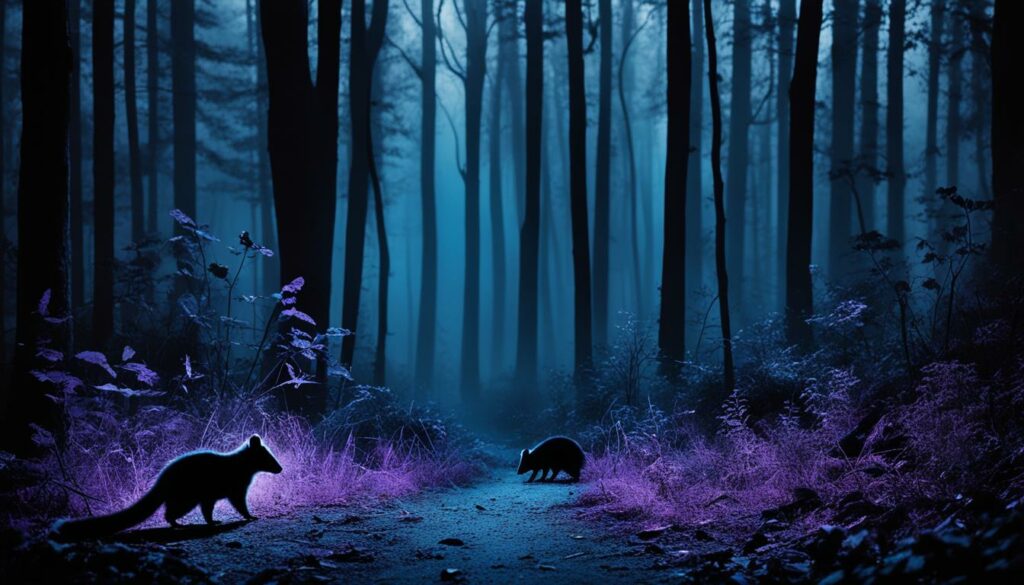
| Aspect | Description |
|---|---|
| Diet | Insects, small mammals, fruits, plant matter |
| Defense Mechanism | Spraying foul-smelling liquid |
| Habitat | Dens in hollow logs, burrows, or under structures |
Coyotes: The Adaptive Night Predators
Coyotes are skilled hunters that have made their mark all over the United States. They do well in cities and the countryside. This shows how they’ve mastered the art of survival in different places. Now, we’ll explore where they live, their range, what they eat, and how they hunt.
Habitat and Range
Coyotes can live in many places, from the wild to our backyards. They aren’t just in the U.S. but also in parts of Canada and Mexico. Their wide home range shows they can live almost anywhere.
Diet and Hunting Strategies
These animals eat almost anything, from tiny mammals to fruits. This diverse diet helps them thrive as night hunters. When they hunt together, they can take down bigger animals. But they’re also skilled at catching small prey alone. Their sharp senses and teamwork make them top predators of the night.
| Characteristic | Description |
|---|---|
| Habitat | Forests, Grasslands, Urban Areas |
| Range | Contiguous USA, Parts of Canada and Mexico |
| Diet | Small Mammals, Insects, Fruits, Livestock |
| Hunting Strategies | Keen Senses, Pack Coordination, Stealth |
Flying Squirrels: The Gliders of the Night
In the USA, flying squirrels stand out among nocturnal animals for their gliding feats. These secretive beings glide between trees at night. They do this using a special membrane called the patagium.
Physical Adaptations
Flying squirrels are made for night life, showing how nocturnal animals adapt. Their patagium, a wing-like structure, lets them glide high among trees. They also have big eyes for seeing clearly in the dark, a must for their night adventures.
Diet and Feeding
Flying squirrels eat a mix of nuts, fruits, insects, and even fungi. They find food at night to avoid enemies and use the dark to their advantage. Their night skills keep them alive as the gliders of the night.
Behavior and Habitat
During winter, flying squirrels get closer, sharing nests to stay warm. They live in forests, making homes in tree holes or leaf nests up high. This living choice protects them from foes and provides food easily.
The table below outlines the key aspects of flying squirrels, illustrating their unique adaptations, diet, and habitats:
| Aspect | Details |
|---|---|
| Physical Adaptations | Patagium for gliding, large eyes for night vision |
| Diet | Nuts, fruits, insects, fungi |
| Behavior | Social behavior, especially in colder seasons |
| Habitat | Wooded areas, tree holes, and leaf nests |
What are the most common nocturnal animals in the USA?
The USA is home to many nocturnal animals. Some common ones are raccoons, opossums, skunks, bats, barn owls, coyotes, and flying squirrels. Each of these creatures has special traits that help them live and hunt at night.
Raccoons wear masks and find food wherever they can. Opossums, the only marsupials here, eat pests like ticks to keep us healthy. Skunks are famous for their stinky spray but they also eat things that keep the outdoors in balance.
Bats use sound to find their food, eating tons of insects each night. Barn owls fly quietly and eat mice and rats. Coyotes are smart and work together to find food. Flying squirrels move between trees, eating nuts and insects, which helps forests grow. These animals are all key to the night life in the USA, keeping the environment healthy.

